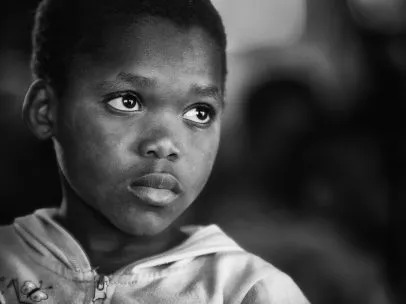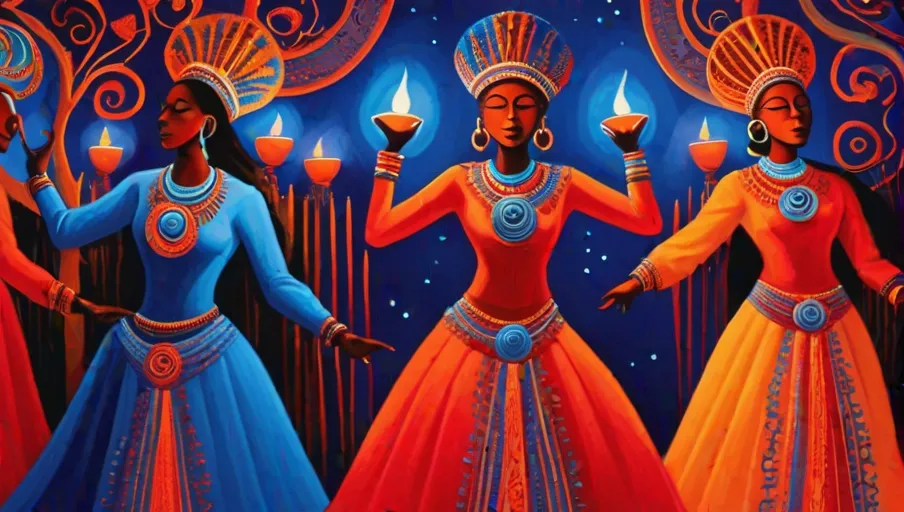
Immerse yourself in the captivating world of Vodou ceremonies, where ancient traditions and spiritual practices intertwine to create a truly extraordinary experience.
In this article, we will delve into the rich tapestry of Haitian culture, exploring the origins, symbols, and rituals that shape these sacred gatherings.
From the appropriate attire to the roles of initiates and Vodou priests, we will unravel the mysteries surrounding Vodou ceremonies, dispelling misconceptions and fostering a deeper understanding of this fascinating tradition.
Join us on this enlightening journey into the heart of Vodou.
- Vodou ceremonies can be referred to as dances and may vary in tone depending on the type of dance and the specific lwa being honored.
- Rada dances are recommended for first-time attendees.
- Vodou dances take place in a peristil, which is a round ceremonial space with an altar at the center.
- Vodou initiates, known for their all-white attire, play a crucial role in leading the ceremony and guiding attendees through the rituals.
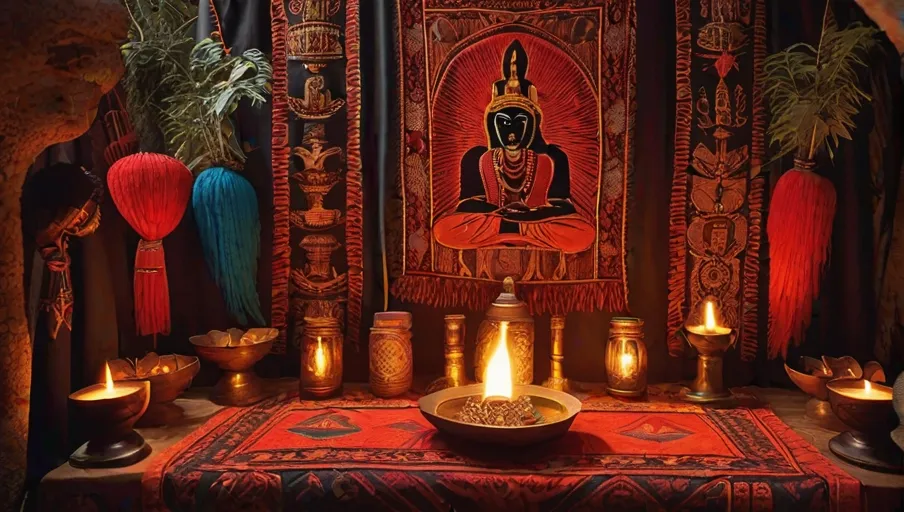
Tracing its roots back to the blending of African spiritual practices and Catholicism, Vodou ceremonies have evolved over centuries, embodying a rich tapestry of cultural history and indigenous beliefs.
Originating in Haiti, Vodou ceremonies hold immense historical significance as they serve as a vessel for the preservation and transmission of ancestral traditions.
Central to these ceremonies is the belief in the importance of ancestral spirits, who are invoked and honored during the rituals. These spirits are seen as intermediaries between the physical and spiritual realms, providing guidance, protection, and blessings to the community.
Vodou ceremonies not only connect individuals with their ancestors but also foster a sense of community, solidarity, and identity. They serve as a powerful reminder of the resilience and strength of Haitian culture, showcasing the deep reverence and connection to the past that continues to shape the present.

During Vodou ceremonies, the altar serves as the focal point of the ritual, adorned with sacred symbols and offerings that are both representative of the spirits being invoked and integral to the spiritual connection between the physical and spiritual realms.
Understanding the symbolism of offerings in Vodou ceremonies is essential to comprehending the deeper meaning behind these rituals. Offerings such as food, drinks, and objects hold symbolic significance, representing the relationship between the human and spiritual realms.
For example, the act of offering food signifies nourishment and sustenance for both the spirits and the participants. Additionally, specific objects placed on the altar, such as bottles and machetes, carry symbolic meanings associated with the spirits being honored.

Appropriate attire and adherence to cultural norms are essential when dressing for and participating in a Vodou ceremony, allowing attendees to show respect and reverence towards the sacred traditions of the event. The Vodou ceremony dress code emphasizes modesty and respect for the spiritual nature of the gathering.
Here are three key points to consider when attending a Vodou ceremony:
- Dress modestly. Avoid wearing revealing or provocative clothing. Choose attire that covers your shoulders, knees, and midriff. Opt for business casual attire such as jeans and a button-up shirt for men and jeans and a blouse for women.
- Respect cultural traditions: Follow the lead of the Vodou initiates and elders. Observe their behavior and follow their instructions during the ceremony. Show reverence for the sacred space and the spiritual beings being invoked.
- Bring an offering: It is customary to bring an offering of unrefined rum called ‘kleren’ to the ceremony. This gesture is highly valued, especially in rural settings. Kleren is considered the fuel of many Vodou dances and is offered to the spirits as a sign of respect and gratitude.
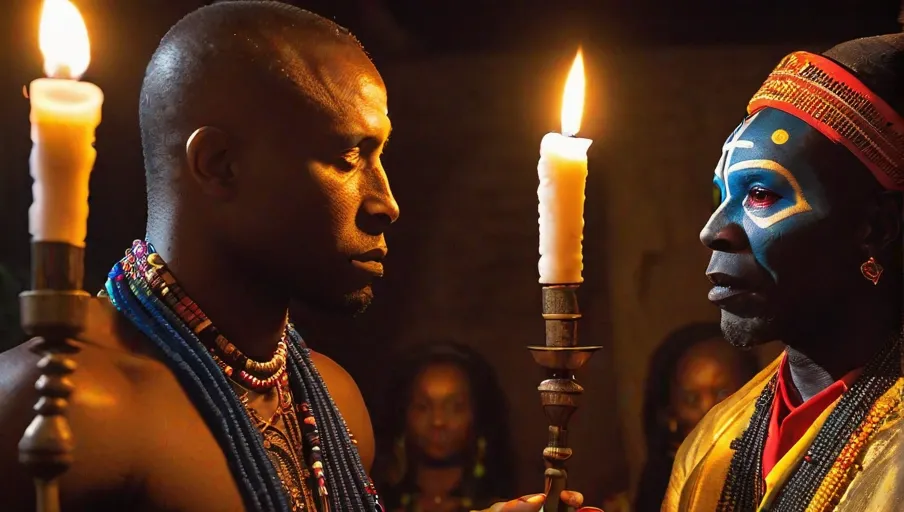
The initiates and Vodou priests play an integral role in orchestrating the dance and guiding the attendees through the rituals and prayers. They are responsible for maintaining Vodou traditions and practices during a Vodou ceremony.
These highly respected figures have deep knowledge and understanding of the Vodou tradition, and their role is crucial in preserving the integrity of the ceremonies.
Initiates and Vodou priests are figures of authority and respect in the community, acting as servants who restore health, harmony, and balance. They intervene in societal hardships and are responsible for leading the attendees in the rituals and prayers.
Their responsibilities include invoking the spirits, performing specific dances, and ensuring that the ceremony flows smoothly.
The initiates and Vodou priests embody the essence of Vodou traditions and are essential in creating an authentic and meaningful experience for all participants.
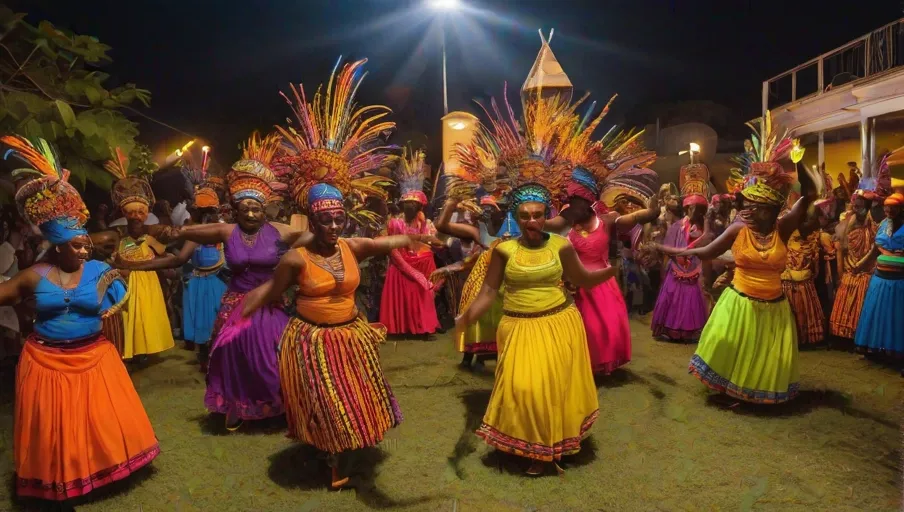
The rhythmic drumming and dancing reverberate through the peristil, setting the tone for the captivating and immersive experience of a Vodou ceremony.
Drumming holds immense significance in Vodou ceremonies as it acts as a bridge connecting the physical and spiritual worlds.
The beats of the drums create a sacred space, inviting the lwa, or spirits, to join the dance. Each lwa has its own unique drum rhythm, which accompanies specific dances associated with their presence.
These dances serve as a means of communication and interaction with the spiritual realm. For example, the Yanvalou dance is associated with the lwa Damballah, the serpent spirit, and is characterized by slow, fluid movements reminiscent of a snake.
The Banda dance, on the other hand, is associated with the fiery and passionate lwa Ogou, and is characterized by energetic and powerful movements.
The combination of drumming and dancing in Vodou ceremonies creates a vibrant and dynamic experience that allows participants to connect with the spirit world in a profound way.
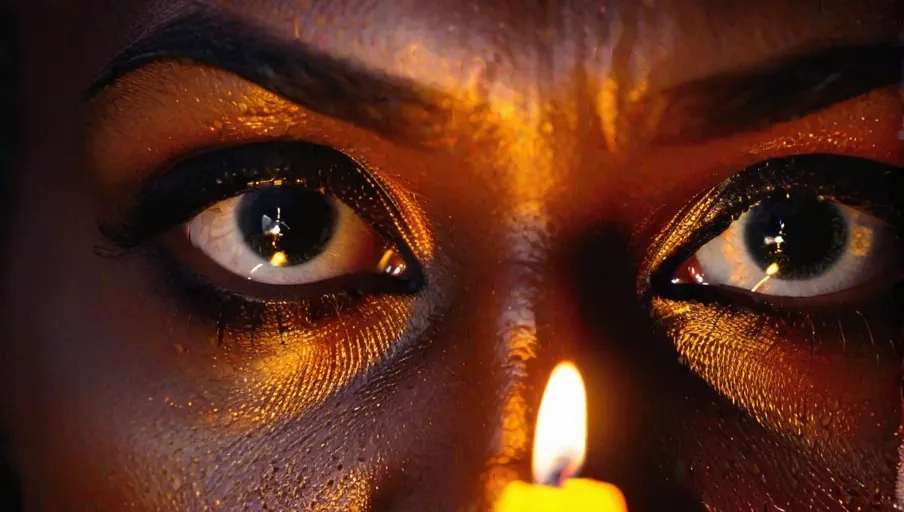
How do Vodou practitioners enter into a state of possession trance, and what role does it play in Vodou ceremonies?
Possession trance is a central aspect of Vodou ceremonies, where practitioners believe that they can be temporarily inhabited by lwa, or spirits.
This transformative experience is highly significant in the spiritual realm of Vodou, as it allows individuals to establish a direct connection with the divine.
During possession trance, practitioners may exhibit various physical and behavioral changes, such as altered voices, intense emotions, and even performing extraordinary feats.
The table below provides a deeper understanding of the spiritual significance and transformative experience of possession trance in Vodou rituals:
| Spiritual Significance | Transformative Experience |
|---|---|
| Establishes a direct connection with the divine | Allows individuals to experience the presence of lwa |
| Facilitates communication between the human and spiritual realms | Provides a channel for seeking guidance, healing, and protection |
| Strengthens the bond between practitioners and lwa | Offers an opportunity for personal growth, spiritual development, and empowerment |
| Enhances the collective energy and power of the ceremony | Promotes unity, healing, and the restoration of balance and harmony |
In Vodou, possession trance is not viewed as a negative or harmful state, but rather as a sacred and transformative experience that serves the spiritual needs of the community.
It is through possession trance that Vodou practitioners can engage in a profound spiritual journey, seeking wisdom, guidance, and healing from the divine forces that encompass the Vodou pantheon.
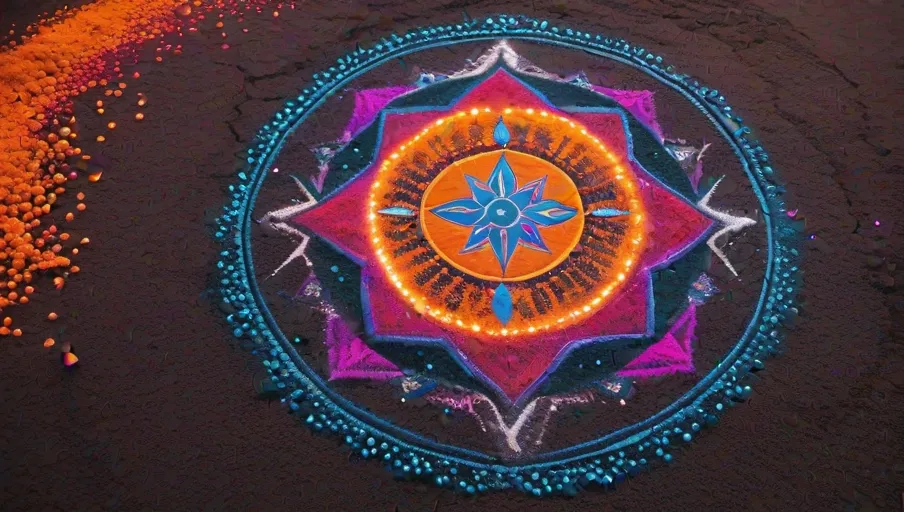
Vèvè cosmograms, intricately traced by initiated Vodou practitioners, serve as sacred symbols that channel the presence and power of lwa spirits during Vodou ceremonies.
These cosmograms hold significant symbolic meaning and play a crucial role in the ritualistic practices associated with Vodou ceremonies.
- Symbolic significance of vèvè cosmograms in Vodou ceremonies:
- Each vèvè represents a specific lwa spirit and acts as a visual invitation for their presence.
- The intricate patterns and symbols convey messages and intentions to the lwa.
- Vèvè cosmograms serve as a spiritual bridge between the human and the divine realms.
- Ritualistic practices associated with vèvè cosmograms in Vodou ceremonies:
- The vèvè is traced on the ground using cornmeal, flour, or other materials.
- The tracing is done with precision and intention, invoking the specific lwa.
- Participants may dance or meditate within the confines of the vèvè, connecting with the energy and presence of the lwa.
The vèvè cosmograms are not only visually captivating but also serve as powerful conduits for spiritual communication and connection during Vodou ceremonies.
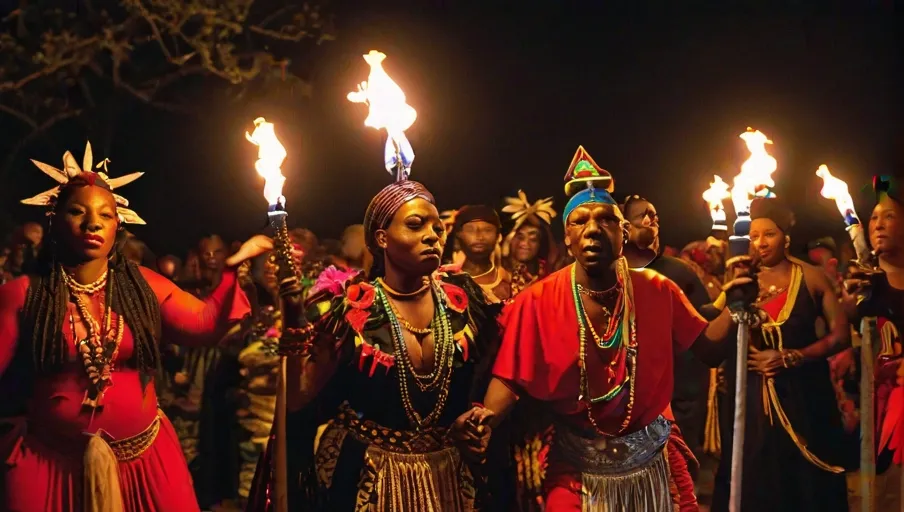
Misconceptions surrounding Vodou ceremonies can be debunked by delving into the truths and cultural significance of this sacred practice.
Vodou ceremonies are often shrouded in mystery and misinformation, leading to misunderstandings and stereotypes. To separate fact from fiction, it is important to explore the spiritual significance of Vodou ceremonies.
In Vodou, drumming creates a passageway to the spirit world, inviting the lwa (spirits) to attend the dance. Each lwa has their own drum rhythm and associated dances, adding depth and meaning to the ceremony.
Initiated Vodou practitioners trace vèvè cosmograms on the floor, symbolizing the presence of the lwa. Possession trance, a result of a successful dance, allows the lwa to communicate and provide guidance.
To further understand Vodou ceremonies, it is crucial to dispel common misconceptions. There is no satan figure in the Vodou pantheon; the lwa serve as intermediaries, similar to saints in Catholicism.
Blood sacrifices are made as a means to ask for good luck, not for any malevolent purposes. Vodou communities welcome all gender expressions and accept same-sex relationships and behavior.
Acceptance and inclusivity are integral to Vodou ceremonies. It is also important to note that many Haitians who follow other religious traditions also seek Vodou guidance.
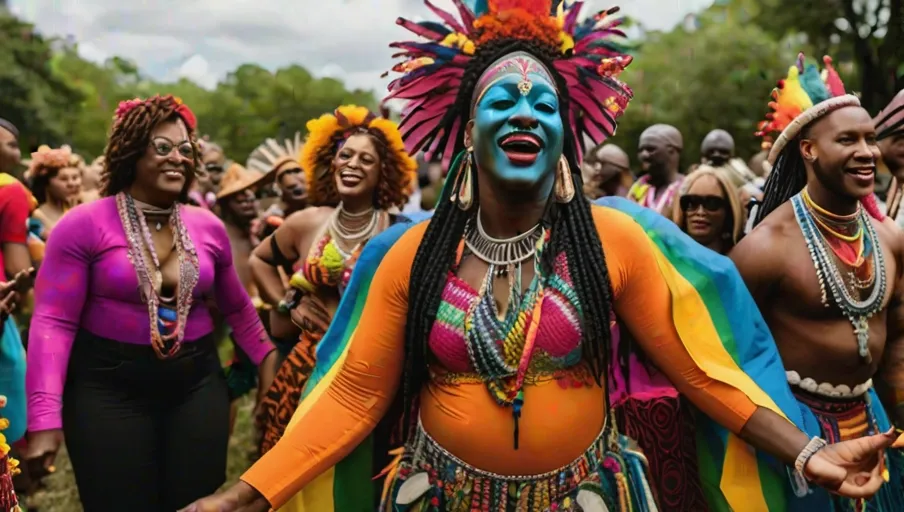
Vodou ceremonies not only embrace diversity but also actively promote gender and LGBTQ+ inclusivity, fostering a sense of belonging for all participants.
In Vodou, gender plays a significant role, with male and female figures holding positions of authority as Mambo and Ougan, respectively.
However, Vodou goes beyond the binary understanding of gender and recognizes the existence of diverse gender expressions.
LGBTQ+ individuals are welcomed and accepted in Vodou communities, challenging the societal norms that often marginalize them.
Vodou ceremonies provide a space where individuals can freely express their gender identity and engage in same-sex relationships without fear of judgment or exclusion.



